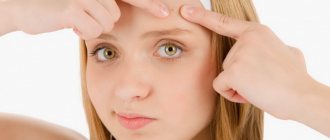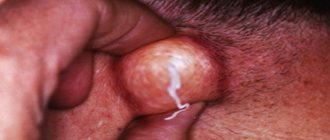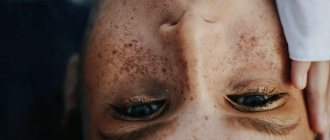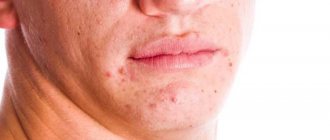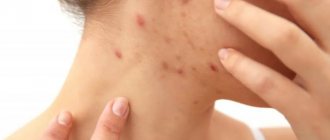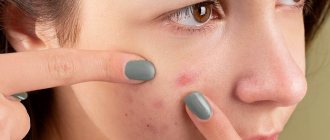Stasya Sokolova: Hello everyone, this is Unashamed Question, Flacon Magazine's podcast about the body. Today our guest is Natalya Chigrova, Candidate of Medical Sciences, dermatologist, cosmetologist. Natasha, everyone knows that you shouldn’t squeeze pimples, but they do it anyway. Here I am, for example. What do you have to say about this?
Natalya Chigrova: Let's start with the fact that as a doctor I must say that pimples should not be crushed. But, as we have already found out, everyone is crushing them. Even, most likely, doctors. Why can't this be done? Firstly, there is such a thing as the triangle of death - this is the area of the nose and the skin of the upper lip. If you squeeze out a particularly large pimple in this area, the infection can enter the bloodstream and then into the sinuses of the brain. This occurs due to the characteristics of the blood supply to the area. As a result, there may be huge problems, because of which one can even go to the forefathers. There really are such cases. Their cause, as a rule, is boils, that is, very large purulent elements.
Stasya: So a pimple on your nose can kill you?
Natalia: Yes, a pimple on your nose can kill you.
Stasya: Ler, will that stop you?
Lera: Firstly, this doesn’t stop me, and secondly, it still sounds like a conspiracy theory. The only triangle of death that I know about is the Bermuda Triangle, and nothing has been proven there.
Natalya: Unfortunately, it’s true about the triangle of death. I'm not sure that this is a directly medical concept described in anatomical reference books, but among doctors we use this term. The only thing I have to make a reservation is, of course, we are not talking about some small pustules. It’s still unlikely that you can die from a squeezed out blackhead, although, probably, anything can happen.
What is post-acne
Acne can appear on the face and neck, in the interscapular area, on the back and in the upper chest. Acne or acne is the formation of inflammatory elements on the skin - compacted reddened tubercles (papules) and blackheads, purulent white heads with redness around them. If elements are injured, squeezed out or heal poorly, post-inflammatory, scarring, and pigmentary changes form on the skin - this is post-acne.
This is what post-acne looks like
So which method is most effective?
Is it difficult to understand the many methods? Not at all. An experienced doctor will quickly select the correct treatment regimen on an individual basis. All these procedures are carried out quickly and painlessly. They may be preceded by a soothing and relaxing massage procedure, which is also effective for problem skin. For example, a deep lift-massage performed on a device that imitates a Jacquet pinch massage, aimed at kneading deep stagnant elements and draining the sebaceous glands. This is a cozy and pleasant procedure, during which people fall asleep, especially after a working day. It can be combined with other types of treatment (as a preparatory stage for peeling, mesotherapy treatment) to combine relaxing care and treatment of problem skin.
The editors thank the specialists of the BioMi Vita clinic for their assistance in preparing the material.
Reasons for the appearance and areas of localization of post-acne
The skin is the largest organ in the human body, and it has a complex structure. In addition to the epithelial cells that form the continuous skin, there are also hair follicles, sweat and sebaceous glands. It is the glands that secrete sebum and form a protective hydrolipidic mantle on the surface of the epithelium that suffer during the development of acne.
To begin with, it is important to understand why acne occurs. When the sebaceous glands malfunction, the epithelium in the area of the ducts thickens, the lumen of the gland narrows and sebum cannot be regularly and fully released through the pores to the surface. Then the fatty secretion is retained inside the gland duct itself, which provokes inflammation with the participation of microbes that are constantly present on the surface of the skin, making up its microflora.
The process of acne formation goes through certain stages:
Initially, comedones are formed - an increase in the size of the sebaceous gland. Nodules form in the skin with an irritated opening of the sebaceous gland. As the process develops, black dots form in the center, and disturbances in the outflow of sebum, microbial activity, and the work of leukocytes during inflammation lead to the formation of purulent heads (pustules).
By themselves, these elements can leave behind scars and uneven skin, and if they are further injured, if you squeeze out blackheads or purulent heads, the inflammation only intensifies, and the purulent contents can spread to neighboring areas of the skin.
To prevent inflammation from spreading, to prevent damage to more and more areas of tissue, and to prevent pus from penetrating into neighboring areas, inflammatory changes form around the damage to the sebaceous gland.
Swelling occurs in the area of the pimple, collagen production is stimulated, scar changes are formed: connective tissue elements are formed, new capillaries grow, which gives redness, the work of pigment cells is stimulated - pigment spots are formed - persistent and with uneven edges.
Especially often, problems arise on the face, mainly in the forehead, on the nose and cheeks, on the chest, they also appear in the décolleté or on the back.
Redness disappears over time, pigmentation becomes less bright, scars can atrophy, forming dimples, or, conversely, become convex and rough.
Why are dermatologists against us popping pimples ourselves?
Because most of us don't know how to do it correctly to avoid consequences. All of them are unpleasant, painful and only worsen the appearance of the skin: if you use your fingers or, worse, nails, there is a risk of infection, and the damage can turn into a scar.
There is an area on the face with the ominous name “triangle of death”. This is not a medical name, but a colloquial name. The zone is a figure with a base at the corners of the lips and a peak at the back of the nose. In this area, due to the peculiarity of the blood supply, it is dangerous to squeeze pimples, since there is a connection with the blood vessels of the brain. If an infection is introduced through a wound, the microbes travel through the blood directly to the brain - this is how meningitis develops. This happens rarely, up to one and a half cases per 100 thousand people per year, but it is better not to touch acne in the area of the death triangle.
In other areas of the face, the worst thing that can happen if you do not follow safety precautions is a staphylococcal infection. According to statistics, this happens in 200 cases per year per 100 thousand people. Symptoms: the face is swollen, red and very painful, and you cannot do without the help of a doctor.
If you follow the rules of hygiene and arm yourself with an arsenal of effective remedies, you can squeeze out a small pimple at home. But first, we’ll tell you which pimples are best left untouched.
Types and stages of post-acne
Among the main signs of post-acne, hyperpigmentation is identified - these are areas of normally colored and darker skin, alternating with each other and forming an uneven tone.
In addition, the typical presence of stagnant red spots, enlarged skin pores, often filled with sebum, as well as pathological scars. In the area of blockage of the sebaceous glands, atheromas (sebaceous gland cysts filled with fatty secretions) or milia (whiteheads) are formed.
The main sign of post-acne is old cicatricial changes, scars after healed purulent acne. They can take three forms:
- depressed areas of skin, dimples (or atrophic scars);
- convex, lumpy areas, often with areas of erythema (hypertrophic);
- areas of dyschromia (the surface of the skin is spotty, with areas of increased pigmentation).
Sometimes the formation of keloid scars is mistakenly added to the classification. This is the wrong approach. People with a hereditary predisposition to the formation of rough and poorly healing scars that disfigure the appearance do not often suffer from acne, and therefore post-acne phenomena are rare for them.
The most common type of post-acne is the appearance of atrophic scars. According to the Jacob CI classification, they can take the form of rounded, chipped and square elements. This division helps doctors plan treatment and predict its results.
Round scars are the shallowest, and the prognosis for them is the most favorable. The square ones are somewhat deeper, but are also eliminated quite well. The biggest problem is the chipped forms of post-acne, they look like the Latin letter “V”, their bottom is located deep in the dermis.
Types of skin damage from acne
What are the sebaceous glands for?
Normally, the sebaceous glands are designed to produce sebum in order to protect and strengthen the skin, but under the influence of improper care, poor ecology, nutritional habits and hormonal levels, their work malfunctions.
In addition to the volume of sebum secreted, its thickness also matters. The thicker the secretion, the more difficult it is for it to come out. The abundant thick secretion literally “bursts” the walls of the gland, which is why seals of different diameters are visible on the skin: from tiny balls to quite large nodes, over which the color of the skin can even change, acquiring a slightly bluish tint. The accumulation of sebaceous secretions attracts bacteria that live on the skin, since sebaceous secretions are an excellent breeding ground for them. As they multiply, they cause inflammation, soreness and redness of the skin. When the main defect is not eliminated - stagnant accumulation of sebum - such local inflammation can “smolder” for weeks, forming acne or pimples.
Based on the above, there are three steps to healthy skin.
Ways to get rid of post-acne
The intensity of post-acne is directly related to the severity of acne. Therefore, it is important to work not only to eliminate the consequences, but also to prevent the appearance of new elements on the skin. It is necessary to fight acne itself, eliminating its main causes. If pimples appear again and again, the prognosis for post-acne treatment is questionable; inflammation will give rise to new scars. Therefore, work with an experienced dermatologist-cosmetologist is required.
Most of the work on restoring, smoothing the skin and eliminating scars is carried out by a cosmetologist, but certain activities can also be performed at home. Moreover, only an integrated approach will give the most maximum results.
What can you do at home?
At home, you need to help the skin recover; it needs building elements and proper nutrition. To regenerate the skin and form its structure, it is necessary to supply vitamins and minerals, protein as a source of amino acids for the construction of collagen fibers and the synthesis of hyaluronic acid, which moisturizes and gives the skin tone and smoothness.
In addition, omega acids are important, which are involved in cell renewal and form cell membranes. It is important to adjust your diet, eliminate as much processed foods as possible, food chemicals (dyes, preservatives, E-additives) and give up bad habits.
To prevent new acne and improve tone, nourish the skin, heal inflammation and small scars, pharmaceutical products will help. You can use 1% salicylic alcohol or boric acid and wipe the skin with it twice a day. Levomekol ointment works quite well in treating acne, suppressing inflammation and eliminating scars. Many people use bodyaga powder, which is diluted in water to a paste and applied to the affected area. But before using all these remedies, it is important to first consult with your doctor to prevent side effects and complications.
Skin care is complemented by serums, care creams (day and night) selected by a cosmetologist, as well as homemade peelings with fruit acids. They delicately exfoliate the skin, remove dead cells, and cleanse its surface.
Folk remedies are often used, for example, infusions of St. John's wort and chamomile, which have an anti-inflammatory, soothing, cleansing effect. You can freeze them and wipe the skin with the resulting ice cubes, further increasing blood circulation and capillary tone.
You can also use masks with blue clay. The recipe for making a mask is very simple: three tablespoons of powder are diluted in water to a paste, applied to the problem area for 20 minutes and then thoroughly washed off with water.
What treatment methods are used in a cosmetology clinic?
Although homemade recipes help in the fight against post-acne, you should not think that only through them you can eliminate all problems. Home methods act on the very top layers of the skin and reduce only minor defects.
Modern cosmetic procedures will help get rid of deep scars, pigmentation and unevenness. But don't expect instant results.
Treatment methods are selected individually and comprehensively. The more severe the initial problem and the wider the affected area, the longer the treatment will be.
To achieve maximum smoothness of the skin and an even complexion or eliminate blemishes on the body, you need a whole series of procedures, supplemented by home care and carefully selected cosmetics. On average, the first noticeable results will be visible after 1-2 months with regular implementation of all necessary treatment measures.
If there is unevenness, decreased skin tone, pigmented or stagnant spots, peelings . There are a lot of treatment options: these can be mechanical peels (compositions with herbs, small dense particles) and chemical peels (with retinol, glycolic, resorcinol or other compounds).
With mechanical peeling, the effect of cleansing and exfoliation is achieved due to the mechanical scraping of the particles included in the composition of the upper layer of skin with outdated epithelial cells.
With chemical peeling, a similar effect is achieved through chemical cauterization of the upper layer of the epidermis, which leads to its subsequent rejection with peeling.
The cosmetologist selects peelings to suit your needs and strictly follows all the rules for their implementation in order to achieve maximum effect and avoid side effects. On average, the first results are visible after 5-6 procedures.
A more effective analogue of peeling is laser skin resurfacing . The doctor performs the procedure with a special laser unit with a strictly specified wavelength in order to influence the skin at the required depth without damaging neighboring tissues. The laser beam cauterizes the skin, the treated areas are actively exfoliated, which allows stimulating the regeneration of new tissues, more even and smooth.
Check out our patient's review of laser facial resurfacing:
Photothermolysis is a more advanced method of laser skin treatment. The rays do not act as a continuous field, but as individual points - creating a mesh on the treated area. This is a fairly effective, but less traumatic effect; the rehabilitation period after such procedures is reduced.
dermabrasion is used to combat skin imperfections . This is the use of aluminum oxide powder under pressure or a special rotating abrasive disc for mechanical grinding of the skin, removing the upper layers of the epidermis from it.
Filler injections can help eliminate atrophic scars and dimples and smooth out the skin . They are inserted under the defect area, create additional volume, and lift depressed skin. The effect lasts up to 6-10 months (depending on the drug), then the injections are repeated.
Mesotherapy with drugs that stimulate collagen synthesis and epidermal renewal gives good results A series of microinjections are made into the surface layers of the skin with the introduction of hyaluronic acid, antioxidants, and vitamin components. The cosmetologist selects a specific drug depending on the tasks and the severity of skin defects.
Another method is ozone therapy . This is a technique of introducing a special oxygen mixture into a problem area through a series of microinjections. The composition helps saturate tissues with oxygen, stimulates blood circulation or lymph drainage, and epithelial regeneration.
If no other methods have produced a significant effect, surgical removal of scars can be used. The affected scar tissue is excised within the boundaries of healthy skin. The rehabilitation process is long, and the intervention itself can also leave scars in the future.
Post-acne treatment at Dr. Gruzdev’s clinic:
Chemical peeling The clinic offers gentle superficial peels: almond and glycolic.
More details
Laser resurfacing Impact of a laser beam on problem areas of the surface layer of the dermis.
More details
Biorevitalization A non-surgical technique for facial rejuvenation using preparations based on hyaluronic acid.
More details
Mesotherapy An injection technique for introducing “cocktails” into the skin based on vitamins, microelements, and amino acids.
More details
TCA chemical peel –
Ice pick scars can be corrected well with trichloroacetic acid (TCA) peels, but this method should be avoided in patients with dark skin due to the high risk of hyperpigmentation. Conducting a medium peel will mean a TCA concentration of 40-50% (only in this case does damage to the papillary dermis occur), and anything below 40% is only a superficial peeling to the depth of the epidermis. Accordingly, we need a TCA of at least 40%.
It should be noted that such a high concentration means certain risks. Therefore, such peeling should only be done by a very experienced dermato-cosmetologist. Below you can see the result after 3 TCA 50% peeling procedures, where the intervals between procedures were 4 weeks. As you can see, a significant improvement has been achieved, and other methods can then be used (for example, laser resurfacing, or the method of perforation removal of individual scars).
TCA chemical peel (before and after photos)
How to quickly lighten or disguise post-acne
It is important to understand that the fight against post-acne is a long-term process; it is necessary to gradually even out the skin, stimulate the regeneration process, normalize blood circulation and metabolic processes in the epidermis and dermis.
Primers, foundations and decorative cosmetics can hide skin defects, but they do not improve, but only worsen the situation, clog pores, prevent the skin from breathing and create a breeding ground for bacteria.
It is impossible to hide acne marks, eliminate scars and even out your complexion by eliminating pigmentation in one day or even a week.
Home peelings will only improve the situation a little, but for deeper effects (chemical peels, laser, mesotherapy) time is needed for rehabilitation (exfoliation, elimination of redness and skin irritation).
To eliminate pigmentation and whiten the skin, a series of procedures and properly selected cosmetic products for subsequent care are required. There are simply no miraculous and safe products that, when applied overnight, will eliminate all unevenness and imperfections.
How to soothe your skin after the procedure
After successfully applying the instructions for properly squeezing out a pimple, aloe juice will perfectly soothe inflamed and reddened skin. It is diluted with boiling water and allowed to brew for about five minutes.
After that, soak a clean napkin in it and apply it to your face for half an hour. To reduce severe redness and swelling, you can apply ice to the affected area.
How to prevent acne and post-acne
To prevent acne and the development of post-acne, you must follow the rules of face and body care. It is important to use cleansing and skin care products selected for your age and skin type, and use them only for their intended purpose and according to the instructions.
Do not squeeze blackheads or white pimples.
To speed up their healing, you can use special creams, serums or other targeted products. If acne does not go away or its number increases, a visit to a dermatologist is necessary.
To protect your skin from inflammation, try not to touch your face or rub it with your hands during the day; if you talk on the phone a lot, treat your gadget, as there are always a lot of bacteria on it that get on the skin.
Change your towels more often or ditch them in favor of disposable paper towels. Be sure to wash your face twice a day and take a shower. For washing, you need to choose mild cleansers. If you are prone to acne, you need a soft, delicate and well-cleansing cosmetic product. Regular soap or shower gel may be too harsh.
Allergic origin of acne
In some cases, acne on the face is of allergic origin and is associated with intolerance to certain types of food. Then the rash intensifies after various kinds of feasts. Such patients are characterized by a combination of skin rashes with other manifestations: for example, fatigue, headache, digestive disorders, bad breath, general skin sensitivity with a tendency to itching and redness. A surge in requests from patients with this kind of acne to a dermatologist is observed after the New Year celebrations, and in the summer - after returning from a vacation from Turkey and Egypt with their abundant buffet.
What to do?
For rashes associated with food intolerance, the best treatment is to select a diet based on an analysis of the patient's eating habits and the doctor's recommendations for replacing certain types of foods with healthier ones.
Sources
- Yuwono NL., Henry CE., Ford CE., Warton K. Total and endothelial cell-derived cell-free DNA in blood plasma does not change during menstruation. // PLoS One - 2022 - Vol16 - N4 - p.e0250561; PMID:33901234
- Mahalingaiah S., Cheng JJ., Winter MR., Rodriguez E., Fruh V., Williams A., Nguyen M., Madhavan R., Karanja P., MacRae J., Konanki SC., Lane KJ., Aschengrau A Multimodal Recruitment to Study Ovulation and Menstruation Health: Internet-Based Survey Pilot Study. // J Med Internet Res - 2022 - Vol23 - N4 - p.e24716; PMID:33861203
- Reavey JJ., Walker C., Murray AA., Brito-Mutunayagam S., Sweeney S., Nicol M., Cambursano A., Critchley HOD., Maybin JA. Obesity is associated with heavy menstruation that may be due to delayed endometrial repair. // J Endocrinol - 2022 - Vol249 - N2 - p.71-82; PMID:33836495
- Xu CC., Li H., Fang YG., Bai TY., Yu XH. . // Zhongguo Zhen Jiu - 2022 - Vol41 - N3 - p.279-82; PMID:33798310
- Kruk M., Matsick JL., Wardecker BM. Femininity Concerns and Feelings About Menstruation Cessation Among Lesbian, Bisexual, and Heterosexual Women: Implications for Menopause. // J Womens Health (Larchmt) - 2022 - Vol - NNULL - p.; PMID:33769080
- Campelo AGD., Lima DA., Britto GRC., Moraes ISL., Almeida RM., Silva-Néto RP. Does menstruation-related headache occur exclusively in women with migraine? // Acta Neurol Belg - 2022 - Vol - NNULL - p.; PMID:33721258
- Bulto GA. Knowledge on Menstruation and Practice of Menstrual Hygiene Management Among School Adolescent Girls in Central Ethiopia: A Cross-Sectional Study. // Risk Manag Healthc Policy - 2021 - Vol14 - NNULL - p.911-923; PMID:33707977
- Ghosh S., Tale S., Handa N., Bhalla A. Rare case of red tears: ocular vicarious menstruation. // BMJ Case Rep - 2022 - Vol14 - N3 - p.; PMID:33687932
- Sang K., Remnant J., Calvard T., Myhill K. Blood Work: Managing Menstruation, Menopause and Gynaecological Health Conditions in the Workplace. // Int J Environ Res Public Health - 2022 - Vol18 - N4 - p.; PMID:33671403
- Thapa S., Aro AR. 'Menstruation means impurity': multilevel interventions are needed to break the menstrual taboo in Nepal. // BMC Womens Health - 2022 - Vol21 - N1 - p.84; PMID:33639917
